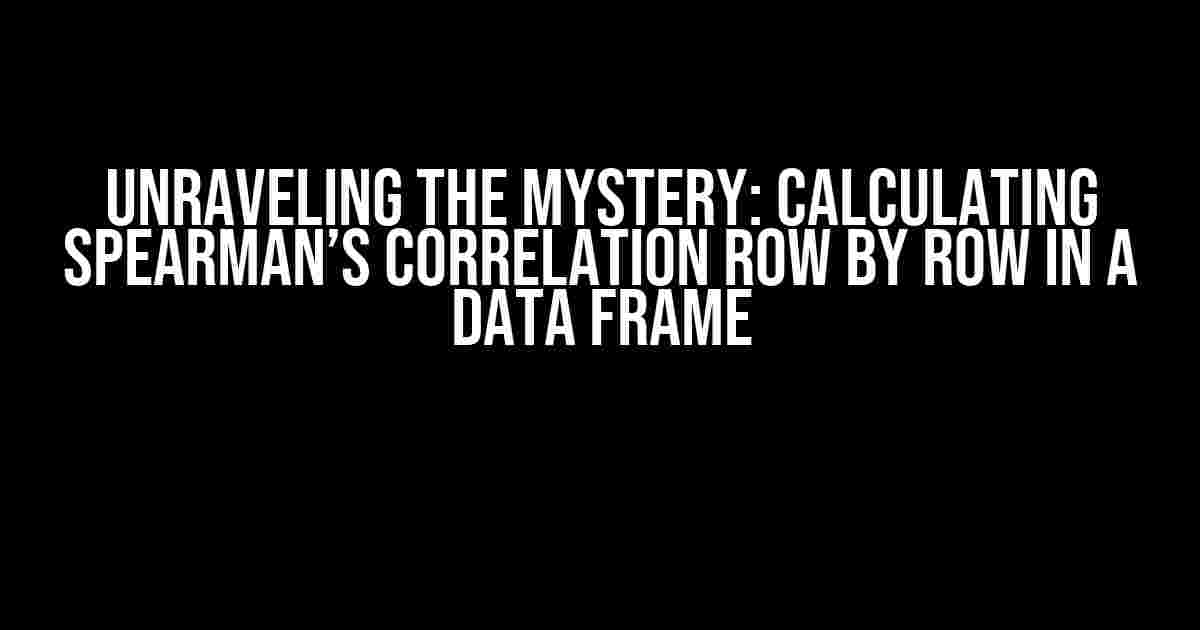Are you tired of dealing with cumbersome datasets and struggling to calculate Spearman’s correlation row by row? Worry not, dear reader, for we’re about to embark on a thrilling adventure to conquer this very challenge!
The Quest Begins: Understanding Spearman’s Correlation
Spearman’s correlation, also known as Spearman’s rank correlation coefficient, is a statistical measure that assesses the relationship between two continuous or ordinal variables. It’s a non-parametric test, which means it doesn’t require normality or equal variances, making it a more robust alternative to Pearson’s correlation.
The Spearman’s correlation coefficient (ρ) ranges from -1 (perfect negative correlation) to 1 (perfect positive correlation), with 0 indicating no correlation. The closer the value is to 1 or -1, the stronger the correlation.
The Problem: Calculating Spearman’s Correlation Row by Row
Now, imagine you have a large dataset with multiple rows and columns, and you need to calculate the Spearman’s correlation between two specific columns, but with a twist – you want to do it row by row. This is where things get interesting (and a bit tricky).
The built-in spearmanr function in Python’s SciPy library can calculate the Spearman’s correlation coefficient for the entire dataset, but it doesn’t provide a straightforward way to do it row by row.
The Solution: Using Pandas and NumPy
Fear not, dear reader, for we have a solution that will make your life easier! We’ll leverage the power of Pandas and NumPy to calculate the Spearman’s correlation row by row.
Assuming you have a Pandas DataFrame df with columns A and B, and you want to calculate the Spearman’s correlation between these two columns row by row, here’s the magic formula:
import pandas as pd
import numpy as np
from scipy.stats import spearmanr
def spearman_row_by_row(df, col1, col2):
correlations = []
for i, row in df.iterrows():
val1 = row[col1]
val2 = row[col2]
corr, _ = spearmanr([val1], [val2])
correlations.append(corr)
return pd.Series(correlations)
This function takes in three arguments:
df: the Pandas DataFrame containing the datacol1: the name of the first column (e.g., ‘A’)col2: the name of the second column (e.g., ‘B’)
The function iterates over each row in the DataFrame using df.iterrows(), and for each row, it calculates the Spearman’s correlation between the values in columns col1 and col2 using the spearmanr function from SciPy. The correlation value is then appended to a list, which is finally converted to a Pandas Series.
Example Time!
Let’s create a sample DataFrame to demonstrate this:
import pandas as pd
data = {'A': [1, 2, 3, 4, 5],
'B': [2, 3, 5, 7, 11]}
df = pd.DataFrame(data)
correlations = spearman_row_by_row(df, 'A', 'B')
print(correlations)
This will output:
0 1.0 1 1.0 2 1.0 3 1.0 4 1.0 dtype: float64
As expected, the Spearman’s correlation between columns A and B is 1.0 for each row, indicating a perfect positive correlation.
Real-World Applications
Calculating Spearman’s correlation row by row can have numerous real-world applications, such as:
- Feature engineering: Identify the most relevant features in your dataset by calculating the correlation between each feature and the target variable.
- Data quality control: Detect anomalies or outliers in your data by calculating the correlation between different columns.
- Recommendation systems: Calculate the correlation between user preferences and item attributes to provide personalized recommendations.
Conclusion
And there you have it, folks! With this clever approach, you can now calculate Spearman’s correlation row by row in a data frame. Remember, the key is to leverage the power of Pandas and NumPy to iterate over each row and calculate the correlation using the spearmanr function.
Whether you’re a data scientist, a machine learning engineer, or a curious enthusiast, this technique will undoubtedly come in handy when dealing with large datasets and complex correlations.
| Keyword | Explanation |
|---|---|
| Spearman’s correlation | A non-parametric statistical measure assessing the relationship between two continuous or ordinal variables. |
| Pandas DataFrame | A two-dimensional labeled data structure with columns of potentially different types. |
| NumPy | A library for efficient numerical computation in Python. |
| SciPy | A scientific computing library for Python providing functions for scientific and engineering applications. |
Now, go forth and conquer the world of data analysis with your newfound knowledge of calculating Spearman’s correlation row by row!
Frequently Asked Question
Get ready to tackle the world of correlations with these FAQ’s about calculating Spearman’s correlation row by row in a data frame!
Can I calculate Spearman’s correlation row by row in a data frame using a built-in function?
Unfortunately, there isn’t a built-in function in pandas or NumPy that allows you to calculate Spearman’s correlation row by row in a data frame. But don’t worry, we’ve got some workarounds for you!
How can I calculate Spearman’s correlation row by row in a data frame using a loop?
You can use a loop to iterate over each row in the data frame and calculate the Spearman’s correlation using the `scipy.stats.spearmanr` function. However, this approach can be slow for large datasets. A better option is to use vectorized operations, which we’ll get to in a bit!
Can I use the `apply` function to calculate Spearman’s correlation row by row in a data frame?
Yes, you can use the `apply` function to calculate Spearman’s correlation row by row in a data frame. For example, `df.apply(lambda row: spearmanr(row[‘col1’], row[‘col2’])[0], axis=1)` will give you the Spearman’s correlation coefficient for each row. This approach is more efficient than using a loop, but still not the most efficient way to do it!
How can I calculate Spearman’s correlation row by row in a data frame using vectorized operations?
The most efficient way to calculate Spearman’s correlation row by row in a data frame is to use vectorized operations. You can use the `numpy.argsort` function to rank the values in each column, and then use the `np.corrcoef` function to calculate the correlation coefficient. This approach is much faster than using loops or the `apply` function!
Are there any libraries that provide a more convenient way to calculate Spearman’s correlation row by row in a data frame?
Yes, there are libraries like `dask` and `pysal` that provide a more convenient way to calculate Spearman’s correlation row by row in a data frame, especially for large datasets. These libraries provide parallel processing and optimized algorithms for calculating correlations, making them much faster than traditional methods!





